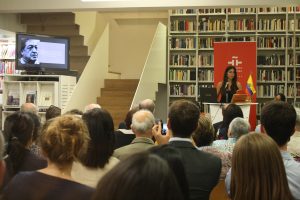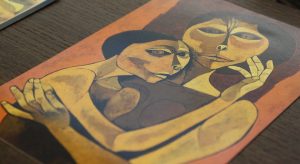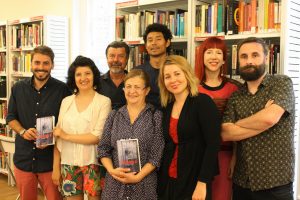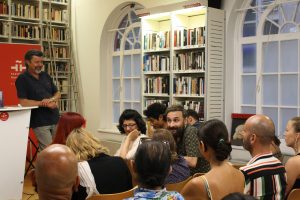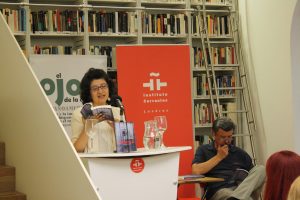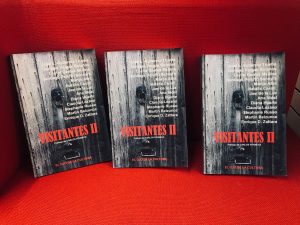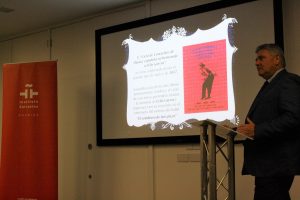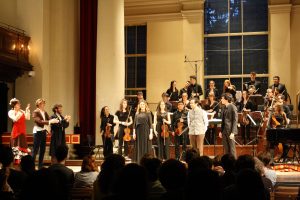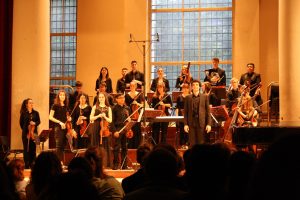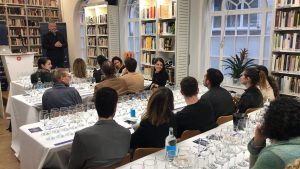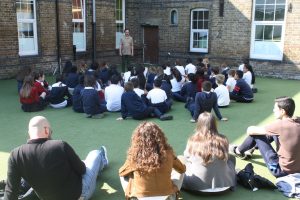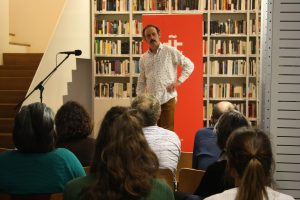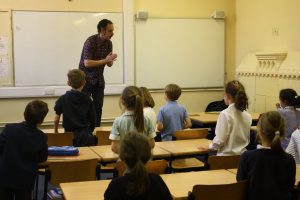Aprende a hacer la auténtica fabada asturiana de la mano de Hispania
Las instalaciones del restaurante Hispania en Londres son parte de la planta baja del edificio histórico de Lloyds Bank. Hispania está ubicado en 72-74 Lombard Street, una de las calles más emblemáticas de Londres, al otro lado de la estación de metro Bank, en el corazón de la ciudad.
Con dos pisos dedicados a mostrar lo mejor de España, Hispania es el proyecto más grande, exitoso y ambicioso dedicado a la gastronomía española en Europa. Y con casi 50 metros de fachada y 8,5 metros de altura total, Hispania tiene licencia para operar como restaurante, bar, tienda y comida para llevar. Casi 9,000 pies cuadrados de espacio hacen de Hispania una tienda insignia de la cocina, comida y cultura española.
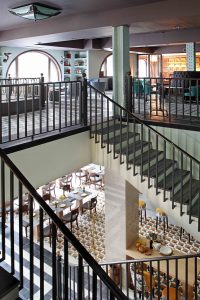
Las instalaciones del restaurante Hispania en Londres
Diseñado por el reconocido diseñador de interiores y anticuario Lorenzo Castillo y bajo la coordinación gastronómica del galardonado chef Marcos Morán, Hispania es la última gran sensación culinaria, que ofrece la mejor experiencia del estilo de vida, la gastronomía y la cultura española en Londres. El destacado arquitecto Tommy Tait, quien también diseñó los famosos grandes almacenes Selfridges, planeó el edificio donde se encuentran las instalaciones de Hispania. En 2007, el edificio se sometió a una renovación completa valorada en más de 65 millones de libras.
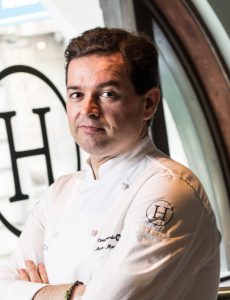
El chef Marcos Morán
Fabada de Prendes, para 4 personas
Ingredientes:
500 kg de fabes seca o 1 kg de fabes frescas (en este caso no hay remojo)
1,5 o 2 morcillas asturianas
2 chorizos asturianos
1/4 sobres de azafrán
Un pequeño trozo de panceta desalada
60 cl de aceite
40 cl de aceite
Una cucharadira de cebolla picada
Sal al gusto
¼ de cucharadita de pimentón dulce
200 cl de caldo de gallina
1 trozo pequeño lacón
MODO DE HACER:
Poner a remojo en agua fría las fabes la noche anterior.
La proporción de agua es de tres a uno, es decir, 500gm por 1 litros. Al día siguiente se ponen las fabes, la panceta y los 60 cl de aceite en recipiente apropiado).
Cocer 10 minutos los chorizos y las morcillas en agua aparte para desgrasar y agregar a la fabada. Antes de empezar el hervor debemos espumar las fabes de las impurezas de la propia legumbre. Aparte, a los 20 minutos del hervor se prepara un sofrito con los 125 cl de aceite, la cebolla picada y el pimentón dulce y lo incorporamos a la fabada con el azafrán diluido en un poco de caldo. Salamos en este momento. Tras el sofrito apagar el fuego y dejar que las fabes reposen. Una vez las fabes reposadas dejamos cocer lentamente durante hora y media teniendo la precaución de ir agregando el caldo que necesiten, nunca pueden dejar de estar cubiertas.
La fabada estará lista cuando las fabes tengan una textura íntegra pero la vez cremosa y delicada en boca.
En recipiente aparte cocemos en agua el lacón para acompañar a las fabes.
FINAL Y PRESENTACIÓN
Presentamos las fabes en legumbrera y el compango troceado en fuente aparte.
El caldo ha de quedar algo espeso; si está muy líquido es aconsejable pasar unas fabes por el pasapurés e incorporarlas al potaje

Un plato de fabada asturiana
La revolución del teatro femenino en español llega a Londres

Las directoras de teatro Paloma Pedrero, Yolanda García Serrano y Daniela Fejerman presentan sus trabajos por primera vez en Londres este otoño, en tres producciones propias del Cervantes Theatre. Las representaciones cuentan con el apoyo de Acción Cultural Española y la colaboración de la ONCE, el Arts Council England y del Instituto Cervantes en Londres, cuyo director, Ignacio Peyró, resalta “la necesidad de hacer visible el gran momento de la dramaturgia femenina en los países hispanohablantes”.
La directora asociada del Cervantes Theatre, Paula Paz, destaca a Paloma Pedrero como “una de nuestras autoras contemporáneas más laureadas y representadas, nacional e internacionalmente”, y desde el Cervantes Theatre quieren que Londres también vuelva a tener la oportunidad de disfrutar de su teatro, esta vez en los dos idiomas, español e inglés.
El año pasado seleccionaron Los ojos de la noche como parte del primer ciclo de Teatro Contemporáneo Español, que desarrollaron junto a Acción Cultural Española, para poder comisionar su traducción y realizarla en lectura dramatizada. “Este año, damos un paso más y presentamos la obra en producción, como cabeza de cartel de un año dedicado a nuestras mujeres creadoras “Ellas toman la palabra”, contando con la presencia de Paloma Pedrero, los jueves 12 y viernes 13 de septiembre, y con un reparto de lujo que incluye dos actores invidentes para representar el papel de Ángel, tanto en la versión española como en la inglesa”, destaca Paz.
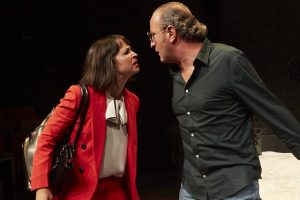
Una vida llena de oportunidades de cambio
La actriz, directora y autora madrileña Paloma Pedrero, cuyo teatro ha sido traducido a varios idiomas, presenta su pieza de teatro breve Los Ojos de la Noche (The Eyes of the Night, en inglés) en el Cervantes Theatre de la capital británica. La obra se representa del 11 al 28 de septiembre a las 7:30pm, con pases en español los miércoles y jueves, y en inglés los viernes y sábados.
Traducida al inglés por la prestigiosa hispanista Catherine Boyle, la obra reflexiona sobre las oportunidades de cambio que pueden surgir en cualquier momento de la vida. Se trata de una obra de gran complejidad y belleza que revela los deseos y miedos más profundos de una mujer de negocios de mediana edad que necesitará sumergirse en la oscuridad para ver la luz.
Un encuentro insospechado entre una mujer madura que supuestamente ha triunfado en la vida y un joven ciego al que ha contratado para pasar unas horas en un hotel puede ser el desencadenante de una nueva vida. Ambos tendrán que ser capaces de abrirse y dejarse llevar.
El primer drama de la premiada Yolanda García Serrano
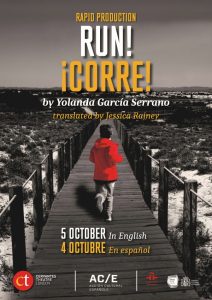
Al Cervantes Theatre también acudirá la guionista, directora y escritora madrileña Yolanda García Serrano, con la obra ¡Corre! (Run!, en inglés), traducida por Jessica Rainey. Ganadora entre otros de un premio Goya al mejor guion por la película Todos los hombres sois iguales, García Serrano presenta al público británico su primer drama, una historia real de dos hermanos, de los cuales él está en la cárcel y ella viene a visitarlo.
La obra de García Serrano profundiza en emociones como el miedo, la culpa, la soledad y el deseo por escapar de un pasado que siempre vuelve al presente. La obra se representa el 4 de octubre a las 7:30pm en español y 5 de octubre a la misma hora en inglés.
Una comedia sobre la estupidez sin barreras
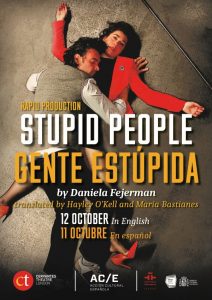
La directora y guionista de cine argentina Daniela Fejerman también presenta por primera vez una obra de teatro en el Reino Unido. Su trabajo Gente Estúpida se puede ver los días 11 y 12 de octubre, en español y en inglés respectivamente, en el Cervantes Theatre.
En la obra, dos hermanos discuten sobre quién debería cuidar a su madre solitaria, una pareja vuelve a dormir junta después de un año de separación, una mujer policía está embarazada, un padre británico tiene como objetivo recoger a su hijo en su cumpleaños y un hombre desesperado asalta a un todoterreno.
Gente Estúpida es una comedia sobre la estupidez, que no conoce barreras económicas, geográficas ni sociales. Fejerman, afincada en España, reconoce que sólo en los últimos tiempos se ha lanzado a escribir dramaturgia: “Empecé a escribir este texto como un ejercicio de libertad: conseguir hacer una película es un proceso largo y desgastante. Mi último largometraje, La adopción, me había costado mucho, y sentí que el teatro era un espacio donde podía moverme sin tantos determinantes”.
Cinema in Spanish stands out in the month of festivals in London
This September, Instituto Cervantes offers a range of events which highlight the support for the presence of Spanish-speaking films and filmmakers in the British capital’s most important festivals and artistic venues (BFI, Open City Documentary Festival, LUX, Tate Modern, Institute of Contemporary Arts, London Spanish Film Festival and Raindance Film Festival).
“The vitality of cinema in Spanish is one of the features that define the current state of cinema in the world. And a cinema with a global appeal, such as ours, must be shown in a global capital such as London,” says Ignacio Peyró, director of Instituto Cervantes in the British capital.
Thanks to Instituto Cervantes, Spanish and Latin-American filmmakers can be part of a range of prestigious festivals held in London, thus increasing the visibility of the productions shot in Spain – be it in Spanish or co-official languages - and Latin America, Peyró adds.
Open City Documentary Festival: A 40-year unsolved mystery
The month begins with the screening of the Chilean documentary feature «The Crosses» and the subsequent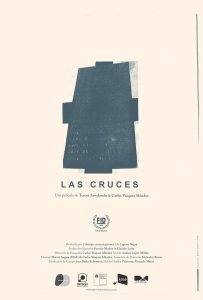 colloquium with the directors Teresa Arredondo and Carlos Vásquez Méndez, on Sunday, September 8 at 1:45 pm, in the Open City Documentary Festival program.
colloquium with the directors Teresa Arredondo and Carlos Vásquez Méndez, on Sunday, September 8 at 1:45 pm, in the Open City Documentary Festival program.
This will be the premiere of Las Cruces in the United Kingdom, which is set only a few days after the 1973 military coup against the Allende government in Chile, when a group of 19 union members in a paper mill disappeared without a trace.
The case was a mystery for 40 years, until a police officer involved in the massacre finally broke the pact of silence. Hearing his confession alongside the testimony of the families of the victims, the filmmakers decipher the events that led to the murders, using 16 mm photographs to represent the landscape as a crime scene.
LUX: Artists works based in the United Kingdom

On Sunday, September 15 at 7:00 pm, a screening of the new works of directors Carla Andrade and Gerard Ortín takes place, with a subsequent colloquium, in the context of LUX New Work screening series, showcasing recent work by artists based in the UK.
Their work is concerned with ideas of landscape, but whereas Andrade is drawn to non-domesticated nature for its unattainability and unownability, Ortín Castellví’s work problematizes the idea of “nature” itself as well as its imagery, often looking at human and more-than-human relations.
They both work across media, with a focus on the moving image. At LUX, a selection of recent works by both artists will be screened followed by a conversation between them and María Palacios Cruz (LUX).
Berwick Film & Media Arts Festival 2019: A dialogue between cultures

Barcelona-based filmmaker Carlos Casas presents the film «Cemetery», a total and hypnotic immersion in the jungle, on the trail of the elephant graveyard, then participates in a colloquium at the Tate Modern contemporary art gallery next Wednesday, September 18 September, at 6:30 pm, at the Berwick Film & Media Arts Festival 2019.
Artist Casas returns to Tate Modern to present the UK premiere of his award-winning feature Cemetery. This deeply sensory film follows an elephant, a mahout and the poachers in their pursuit as they move toward the mythical place known as the elephant graveyard. As the journey transitions from the jungle through stages of death, images begin to fall away, opening onto a rich sonic landscape.
Ten years in the making, Cemetery weaves together field recordings from around the globe, recorded and mixed by wildlife sound expert Chris Watson with the collaboration of professor Tony Myatt (spatialisation and Ambisonics). Finding a striking juncture between nature documentary, experimental film, road movie and soundscape, the film opens up questions about life cycles and memory, colonialism and extinction, conservation and the environment and interspecies relationships.
ICA: The portrait of the youth of a Madrid neighborhood

Pontevedra director Carmen Bellas will participate in a colloquium at the Institute of Contemporary Arts in London (ICA), after the screening of her acclaimed short film «When we were wild», on September 22 at 8:30 pm.
«Being able to screen the film in London is very exciting; it brings us closer to different audiences and thanks to them we can capture other nuances of our project,» explains Bellas.
Once we were wild, a portrait of the young people of a San Cristóbal neighbourhood on the outskirts of Madrid, won the prized Caracola in the feature film category at the 49th edition of the Reach Documentary Festival. This unique and suggestive representation of place progressively abandons a classic documentary structure to become a first person essay.
Raindance Film Festival: The life of Ara Malikian, uncovered

This year, the Cervantes Institute in London also collaborates with the Raindance Film Festival, a prestigious independent film festival, with the screening of the documentary «Ara Malikian: a life between the ropes» and subsequent colloquium with the director Nata Moreno, which takes place on Tuesday 24 September, at 6:00 pm.
The play portrays the versatile violinist Ara Malikian, whose life was saved by music when he fled the war and left Beirut at age 14. Since then he has lived as a nomad carrying his music all over the world. The spectator follows Ara Malikian and his entire team during their last symphonic tour of Spain and countries such as France, China, Argentina and Germany
Moreno is the stage director of the shows of the Malikian, as well as creator and producer of her [JR5] [PE-AT6] music videos and campaigns. In 2016, she set up her own production company Kokoro Films with whichs she carries out various advertising campaigns and personal projects.
Raindance Film Festival: A black comedy with a star cast
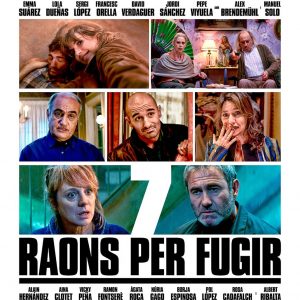 On Thursday, September 26, at 7:45 p.m., the UK premiere of the Catalan comedy «7 raons per fugir», by Gerard Quinto, Esteve Soler, David Torras, followed by a discussion with one of the filmmakers, which is part of the Raindance Film Festival.
On Thursday, September 26, at 7:45 p.m., the UK premiere of the Catalan comedy «7 raons per fugir», by Gerard Quinto, Esteve Soler, David Torras, followed by a discussion with one of the filmmakers, which is part of the Raindance Film Festival.
Soler adapts his own theatrical texts to give way to a black comedy with a star cast in which the dehumanization of the society in which we live is treated through everyday situations that deform.
The family, the poor kid who appears on TV, the sixth-floor neighbours, the tenant and the real estate agent, the business couple, the guy progress has run over and the couple about to get married. Seven stories that intertwine horror and comedy. Seven scenes of black humour as strange as they are unexpected. Seven surreal perspectives on a society that can’t progress, a dysfunctional society.
Showing at the London Spanish Film Festival
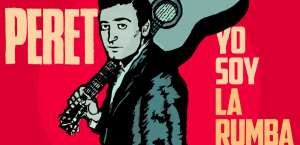
The month of September ends with the participation of the Cervantes Institute in the acclaimed London Spanish Film Festival through two screenings. First, on September 26 at 6:30 pm the documentary Peret will be screened, “Peret: the King of the Gypsy Rumba”, by Paloma Zapata, niece of the acclaimed and respected artist.
Winner of the Best International Film at the MUVI Music Film Festival 2019, it is a must for music lovers. This is an intimate portrait and at the same time a tribute to Pere Pubill Calaf, Peret for the whole world, the king of Catalan rumba for history raised in the humble neighborhood of Sant Antoni, in Barcelona.
Finally, on September 28, at 4:00 pm, the Galician screening of Trinta lumes and a colloquium with its director, Pontevedra Diana Toucedo, takes place. Recorded in the Galician region of O Courel, the director takes us to her roots and shows the reality of the Galician community from the eyes of Alba, the protagonist of this film. A work that foregrounds issues of life and death, delving into the past with a look at the present.
El cine en español protagoniza el mes de los festivales en Londres
El Instituto Cervantes de Londres cuenta con un programa cultural este mes de septiembre en el que destaca el apoyo a la presencia de películas y cineastas hispanohablantes en los festivales y salas más importantes de la capital británica (BFI, Open City Documentary Festival, LUX, Tate Modern, Institute of Contemporary Arts, London Spanish Film Festival y Raindance Film Festival).
“La vitalidad del cine en español es uno de los rasgos que definen el actual momento del cine en el mundo. Y un cine con vocación global, como es el nuestro, debe mostrarse en una capital global como es Londres”, afirma Ignacio Peyró, director del Instituto Cervantes en la capital británica.
Gracias al Instituto Cervantes, cineastas españoles e hispanoamericanos pueden formar parte de gran parte de festivales de prestigio celebrados en Londres, aumentando así la visibilidad de las producciones rodadas en España –sea en castellano o lenguas cooficiales- e Hispanoamérica, añade Peyró.

Las cruces (2018)
Open City Documentary Festival: Un misterio sin resolver 40 años
El mes comienza con la proyección del largometraje documental chileno Las cruces y el posterior coloquio con los directores Teresa Arredondo y Carlos Vásquez Méndez, el domingo 8 de septiembre a la 1:45 pm, dentro del programa del Open City Documentary Festival.
Este será el estreno de Las cruces en Reino Unido, que sitúa la acción solo unos días después del golpe militar de 1973 contra el gobierno de Allende en Chile, cuando un grupo de 19 miembros sindicales en una fábrica de papel desaparecieron sin dejar rastro.
El caso fue un misterio durante 40 años, hasta que un policía involucrado en la masacre finalmente rompió el pacto de silencio. Tomando su confesión junto con el testimonio de las familias de las víctimas, los cineastas descifran los eventos que condujeron a los asesinatos, usando fotografías de 16 mm para representar el paisaje como una escena del crimen.
LUX: Trabajos de artistas con sede en el Reino Unido

Reserve (Gerard Ortín Castellví, 2017-2019) y El paisaje está vacío y el vacío es paisaje (Carla Andrade, 2017)
El domingo 15 de septiembre a las 7:00 pm tiene lugar la proyección, con posterior coloquio, de los Nuevos trabajos de los directores Carla Andrade y Gerard Ortín, dentro del programa de LUX, la agencia de arte internacional que apoya las prácticas de imagen en movimiento de los artistas y las ideas que las rodean.
La viguesa Andrade y el barcelonés Castellví son graduados españoles del título de Cine de Artistas e Imagen en Movimiento en Goldsmiths, Universidad de Londres. Su trabajo está enfocado hacia conceptos paisajísticos. Mientras que Andrade se siente atraído por la naturaleza salvaje por su inalcanzabilidad e imposibilidad, el trabajo de Ortín problematiza la idea de la «naturaleza» en sí misma, en un imaginario no siempre enfocado hacia las ideas humanas de naturaleza.
Ambos trabajan a través de los medios de comunicación, con un enfoque en la imagen en movimiento. Dentro del contexto de la serie de proyecciones New Work en Lux, se proyectará una selección de obras recientes de ambos artistas seguida de una conversación entre ellos y María Palacios Cruz.
Berwick Film & Media Arts Festival 2019: Un diálogo entre culturas

Cemetery, film still (2019)
En el caso del cineasta barcelonés Carlos Casas presenta la película Cemetery, una inmersión total e hipnótica en la jungla, tras la pista del cementerio de elefantes, y participa acto seguido en un coloquio en la galería de arte contemporáneo Tate Modern el próximo miércoles 18 de septiembre, a las 6:30 pm, dentro del Berwick Film & Media Arts Festival 2019.
Esta película profundamente sensorial sigue a un elefante, un mahout y los cazadores furtivos en su búsqueda mientras se mueven hacia el lugar mítico conocido como el cementerio de elefantes. A medida que el viaje pasa de la jungla a través de las etapas de la muerte, las imágenes comienzan a desaparecer y se abren en un rico paisaje sonoro.
A medida que el viaje pasa de la jungla a través de las etapas de la muerte, las imágenes comienzan a desaparecer y se abren en un rico paisaje sonoro. Diez años después, Cemetery teje grabaciones de campo de todo el mundo, grabadas y mezcladas por el experto en sonido de la vida silvestre Chris Watson.
Al encontrar una coyuntura sorprendente entre el documental de la naturaleza, la película experimental, la road movie y el paisaje sonoro, la película abre preguntas sobre los ciclos de vida y la memoria, el colonialismo y la extinción, la conservación y el medio ambiente y las relaciones entre especies.
Para Casas su objetivo ha sido siempre “mostrar al espectador sus experiencias, a través del encuentro y el dialogo con otras culturas y lugares”, que reconoce que han sido siempre el centro de sus intereses.
ICA: El retrato de la juventud de un barrio madrileño

Una vez fuimos salvajes (2016)
La directora pontevedresa Carmen Bellas participará en un coloquio en el Institute of Contemporary Arts de Londres (ICA, por sus siglas en inglés), tras la proyección de su aclamado cortometraje Una vez fuimos salvajes, el 22 de septiembre a las 8:30 pm.
«Poder proyectar la película en Londres es muy emocionante, nos acerca a audiencias diferentes y gracias a ellas podemos captar otros matices de nuestro proyecto”, explica Bellas.
Una vez fuimos salvajes, retrato de la juventud de un barrio de San Cristóbal en la periferia de Madrid, consiguió la preciada Caracola en la categoría de largometrajes en la 49ª edición del Festival de Documental Alcances. Esta representación única y sugerente de un lugar abandona progresivamente una estructura documental clásica para convertirse en un ensayo en primera persona.
Raindance Film Festival: La vida de Ara Malikian, al descubierto

Ara Malikian: una vida entre las cuerdas (2019)
Este año, el Instituto Cervantes de Londres también colabora con el Raindance Film Festival, prestigioso festival de cine independiente, con la proyección del documental Ara Malikian: una vida entre las cuerdas y posterior coloquio con la directora Nata Moreno, que tiene lugar el martes 24 de septiembre, a las 6:00 pm.
La obra retrata al versátil violinista Ara Malikian, a quien la música salvó su vida cuando huyó de la guerra y dejó Beirut a los 14 años. Desde entonces ha vivido como un nómada llevando su música por todo el mundo. El espectador puede seguir a Ara Malikian y a todo su equipo durante su última gira sinfónica por España y países como Francia, China, Argentina, Alemania, etc.
Moreno es directora escénica de los espectáculos del citado músico, así como creadora y realizadora de sus videoclips y campañas. En 2016 montó su propia productora Kokoro Films con la que realiza diversas campañas publicitarias y sus proyectos personales.
Raindance Film Festival: Una comedia negra con un reparto de lujo
 El jueves 26 de septiembre, a las 7:45 pm, tiene lugar el estreno en Reino Unido de la comedia 7 raons per fugir, de Gerard Quinto, Esteve Soler, David Torras, seguida de un coloquio con uno de los realizadores, que se enmarca dentro del Raindance Film Festival.
El jueves 26 de septiembre, a las 7:45 pm, tiene lugar el estreno en Reino Unido de la comedia 7 raons per fugir, de Gerard Quinto, Esteve Soler, David Torras, seguida de un coloquio con uno de los realizadores, que se enmarca dentro del Raindance Film Festival.
Soler adapta sus propios textos teatrales para dar paso a una comedia negra con un reparto de lujo en la que se trata la deshumanización de la sociedad en la que vivimos a través de situaciones cotidianas que se deforman.
Siete historias que mezclan el horror y la comedia. Siete visiones surrealistas de una sociedad que no progresa: la familia, la inquilina, la boda, el empresario, los vecinos, el niño pobre y el atropellado. Un matrimonio que intenta ‘abortar’ a su hijo adulto. Una pareja a la que se le presenta el tercer mundo en casa. Una escalera de vecinos que no recuerdan que va después del seis. Un agente inmobiliario que intenta vender un piso con posibilidades, pero con el antiguo inquilino colgando de la lámpara. Un matrimonio ‘bien’ con setecientos esclavos trabajando bajo el suelo. Un hombre atropellado y una mujer que cree que no merece la pena llamar a la ambulancia. Una pareja a punto de darse el ‘sí, quiero’, hasta que la muerte los separe.
Representación en el London Spanish Film Festival

El mes de septiembre termina con la participación del Instituto Cervantes en el aclamado London Spanish Film Festival a través de dos proyecciones. En primer lugar, el 26 de septiembre a las 6:30 pm se proyectará el documental Peret, yo soy la rumba, de Paloma Zapata, sobrina del aclamado y respetado artista.
Ganador de la Mejor Película Internacional en el MUVI Music Film Festival 2019, es de visión obligada para los amantes de la música. Este es un retrato íntimo y a la vez un homenaje a Pere Pubill Calaf, Peret para el mundo entero, el rey de la rumba catalana para la historia criado en el humilde y gitano barrio de Sant Antoni, en Barcelona.
Por último, el 28 de septiembre, a las 4:00 pm, tiene lugar la proyección en gallego de Trinta lumes y un coloquio con su directora, la pontevedresa Diana Toucedo. Grabado en la región gallega de O Courel, la directora nos traslada a sus raíces y muestra la realidad de la comunidad gallega desde los ojos de Alba, la protagonista de esta película. Una obra que plantea un escenario sobre las cuestiones de la vida y la muerte, ahondando en el pasado con una mirada hacia al presente.
Ecuador and Spain introduce Guayasamín in London as one of the great artists and witnesses of the 20th century
The Embassy of Ecuador and Instituto Cervantes celebrate, in London, the 100th anniversary of the birth of the great Ecuadorian painter and artist Oswaldo Guayasamín, with a conference by Goldsmith University art historian and artist Daniela Galán and the dance anthropologist, dancer and actress Estefanía Solórzano.
«As Ambassador of Ecuador in the United Kingdom, it is an honor to commemorate this month, at Instituto Cervantes in London, the centenary of the birth of the artist Oswaldo Guayasamin, a giant from Ecuador and America, whose work is known around the world, his plastic creations are moved by his aesthetic strength and the enduring message of eternal works,” explains Jaime Alberto Marchán Romero, Ambassador of Ecuador to the United Kingdom.
Marchán Romero emphasizes that the Ecuadorian master dominated all the expressions of art: canvas, mural composition, sculpture and prints. Romero added that, in the intellectual field, Guayasamín played a decisive role in the struggle for his ideals of social justice. “Through his brush, he spoke for the oppressed of the world. His cry was immense and still resonates, angry and haughty, in museums, walls and squares, but, above all, in the hearts of men,” he adds.
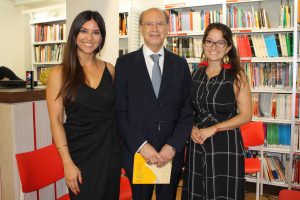
The Ambassador believes that this event at Instituto Cervantes has a special significance, as it is an opportunity to make the work of the great Ecuadorian artist better known in this cosmopolitan country. It also renews in Instituto Cervantes, “the deep ties that unite Latin American countries through language, culture and art, through which we have enriched each other.”
“Guayasamín is an artist who seems to summarize the greatness and contradictions of Latin America. Beyond its plastic power, so characteristic and so linked to the traditions of the subcontinent, all Latin American themes are in it. And I say Hispanic Americans because few artists have made such a good bridge between America and Spain. For us it is a joy to open the doors to Guayasamín and Ecuador on their national day, ”says the director of the Cervantes Institute in London, Ignacio Peyró.
In Ecuador, when Estefanía Solórzano began her theatre studies, she began to go to museums a lot and also approached Ecuadorian painting, dance and literature. It was at that time when she also rediscovered the work of Guayasamín and began to frequent the museum ‘La chapel of man’, in Quito, built by the artist in homage to the human being.
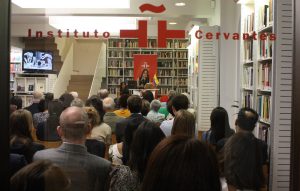
The most intimate expression of the human being
Guayasamín was always surrounded by many artist friends (painters, musicians, writers, etc.) and Solórzano was interested in knowing the history of that circle. “The focus on the eyes, hands and face always struck me. I see it as the way in which one gets to know another person through the eyes. Guayasamin offers us the most intimate expression of the human being in the eyes and hands, and that is where terror, love, tenderness and poetry are,” she explains.
Solórzano began her MA in Dance Anthropology two years ago, on an itinerary that took her to Norway, France, Hungary and finally to the United Kingdom last January. Currently, she develops a project based on memory and oblivion, for which she was inspired by one of Guayasamín’s works: “As long as I live forever, I remember you”, which belongs to the series ‘The age of tenderness’.
«The skin outside, the skin inside»
Solórzano identifies with Guayasamín and his idea of «The skin outside, the skin inside». In the first one, Guayasamín refers to his artistic work in the time he has lived; while, in the second term, he encompasses all the experiences of a child and what he lived with his family, facts that moved him all his life.
Guayasamín describes that he painted ‘The Age of Wrath’ as if he were screaming desperately, adding to all those screams that express the humiliation and anguish of the horror events experienced by Humanity in the twentieth century.
The construction of a world art scene
In the case of historian Daniela Galán, her talk revolves around the importance of the artist in the context of the history of Latin American art and its impact on the construction of the world art scene. Anger will be the starting point to examine how Guayasamín and other artists approach the indescribable, situations of pain, trauma and violence, without falling into sensationalism.
«In the paintings of Guayasamín you can see not only the pain of the victims, but also the frustration of living in certain historical moments and having lived so much pain, such as the Holocaust, the Spanish Civil War or the bombs of Hiroshima and Nagasaki», explains Galan, for whom Guayasamín is indispensable in the history of Latin American art. He also drew attention to the rights of the indigenous, with his mixture of indigenous and mestizo.
London opens the door to literature in Spanish language
Instituto Cervantes in London welcomes the presentation of a book celebrating twelve Spanish and Latin American authors living in the British capital.
Twelve Spanish-language authors from Argentina, Bolivia, Uruguay, Mexico, Nicaragua, Spain and Ecuador will speak today at 7pm at the London headquarters of Instituto Cervantes. All the writers now live and work in London, and their new book, Visitors II was written after attending the creative writing workshop, El Ojo de la Cultura Hispanoamericana (The Eye of Hispanic American Culture).
«London is a literary and creativity capital in Spanish because of the number of Spanish speakers who create in it,» says Ignacio Peyró, director of the Cervantes Institute in London, who highlights the Latin American vocation of the centre.
The twelve Spanish and Latin American authors are: José Luis Gutiérrez Trueba, Denisse Vargas Bolaños, Lester Gómez Medina, Santiago Peluffo Soneyra, Marijo Alba, Natalia Casali, Jael de la Luz, Ana Vidal, Diana Huarte, Claudia Lozano, Stephanie Russo and Martín Belzunce, coordinated by the Argentine writer Enrique D. Zattara.
All of them will talk about their work and their experience after attending the writing workshop that Zattara started in September 2015 and through which thirty writers have attended both face to face or online.
The Eye of Hispanic American Culture, ZTR Radio and Instituto Cervantes in London have been collaborating together since October 2017 in the “Authors in search of reader” cycle, aimed at spreading the work of Spanish-American writers still little known in this country among the British readers.
Writing workshops to improve stories
Zattara highlights the role of writing workshops to help writers, through the development of techniques and resources to improve the story and going through what will work or not. In addition, he explains how they disassemble the stories and resources used by writers such as the Argentine Jorge Luis Borges.
“Ricardo Piglia said that the first writings were particularly interesting because they were portrayed in the search for a style and the commitment to a way in which to think about literature”, says writer Carlos Fonseca, author of the prologue in this book. «The beauty of a book like this falls, then, on that style and form are thought collectively.»
In the case of the writer Lester Gómez Medina, a Costa Rican of Nicaraguan origin, four of his short stories are included. In them, he gathers his childhood experiences and how they impact on adult life. Gómez Medina highlights the role of the workshops as a speaker of the Spanish language in London, as well as to consolidate the writing and create a link with other writers to whom he already calls friends.
On the other hand, Diana Huarte, Argentine singer of electronic music of the group called Shh, arrived at the writing workshop two years ago after a health problem and eager to develop her creativity. In addition, the Cantabrian José Luis Gutiérrez Trueba joins the project with his stories, inspired by ideas that he takes from the street, news he is reading throughout the day, reflections of the current era and the impact of social networks and Brexit.
A project to spread to Spanish-speaking creators
The Eye of Hispanic American Culture in London is a multimedia cultural project that aims to communicate and disseminate with Spanish-speaking artistic creators worldwide. They develop their motives through various formats, such as radio culture, through ZTR radio podcasts in which they carry out exclusively cultural programming in Spanish and English, which is also broadcast live in collaboration with ExraRadio1 of London.
In addition, they make cycles, readings and conferences for the dissemination and knowledge of Hispanic-American artists, in Spanish and English. These projects are both lone-ventures as well as in collaboration with institutions such as the Cervantes Institute, various Latin American Embassies, and some universities. They also organise public shows where they stage encounters of artistic disciplines such as poetry, music and dance, theater, cinema for the audience.
The hidden story of ‘The three-cornered hat’ by Spanish composer Manuel de Falla
On the occasion today of the centenary of the premiere of the ballet ‘The Three-cornered Hat’ (22nd July 1919), the research, carried out in the last two decades by the Spanish writer, musician and teacher Antonio Hernández Moreno, reveals that almost a third of the ballet score by Manuel de Falla was composed and orchestrated by composers Maurice Ravel and Ottorino Respighi.
The researcher made this information public at a lecture hosted by the Instituto Cervantes in London, hosted at the Europe House. The writer found in the Houghton Library (Harvard University) an unknown manuscript score of the ballet complete music on piano version under the title ‘Le Chapeau tricorne’. The study demonstrates, once analysed the calligraphic features and modifications made on the previous work composed by Falla under the title of ‘The Governor and the miller’s wife’, that Ravel and Respighi arranged, finished and orchestrated the work that would become the final score of the ballet ‘The Three-cornered hat.’
In June 1916, the Russian impresario Sergei Diaghilev (in gratitude for the aid received by King Alfonso XIII in the release of Nijinsky from a concentration camp at the beginning of the World War) agreed in Madrid with the playwright Gregorio Martínez Sierra to adapt the famous novel by Pedro Antonio de Alarcón, into a plot for a Spanish ballet to be premiered by the Ballets Russes. Manuel de Falla was the chosen composer by Diaghilev.
After a first failure attempt to premiere the ballet in Rome at the beginning of 1917 with Spanish ‘bailaores’, and after a serious disagreement with Nijinsky – already released and in Spain- to be represented with Pastora Imperio; Diaghilev finally hires the young and brilliant Spanish dancer Félix García, to teach the Spanish rhythms to the members of the company and also play the main role of the ballet. Felix Garcia, was not only a musician but also a very gifted ‘bolero’ or ‘bolerist’ (name given to a virtuoso dancer specialised in Spanish national dances), and not an Andalusian ‘bailaor’, as it was believed until now.
At that time, the Diaghilev’s Ballets Russes was stuck in Spain because of the World War, so after a rugged performances in Lisbon and a tour through some Spanish cities, and almost become dissolved, Diaghilev managed to release it from the blockade thanks once more to the diplomatic efforts made by King Alfonso XIII, which finally allow Diaghilev and his company to travel to London in August 1918.
After a long season at the Coliseum Theater in London, the company moves to the Alhambra Theater, where Diaghilev has already planned to premiere ‘The Governor the miller’s wife’ along with another Spanish character ballets. But new setbacks and delays, including the never finishing of the final ballet score by Falla, caused Diaghilev to secretly hire the composers Ravel and Respighi services to finish it. The replacement of Felix and Sokolova replacement in their main roles, and the confine of the Spanish dancer in a mental hospital did not prevent the ballet, now retitled ‘The Three-cornered Hat’ was premiered ‘in extremis’ on the last day of the season performance. Picasso designed sets and costumes, making a pencil drawing of Felix and Sokolova during a rehearsal, the only surviving image of the Spanish dancer.
Hernandez-Moreno establishes as well a parallel between what happened to Felix Garcia and the final destiny of the legendary Russian dancer Vaslav Nijinsky. The research also concludes that the orchestral masterwork ‘Bolero’ by Ravel was inspired, motivated and secretly dedicated to Felix. The results of this study have been published in a novelized way in the book ‘Thirty castanets for London’ that will be coming soon in weeks.
On the other hand Hernandez Moreno has promoted and managing a Spanish music and dance festival for three years in homage to Félix García, with the aim of honouring his memory and trying to erase the unfair nickname of ‘Felix the Mad’, maliciously or wrongful named for several decades.
The passage of Diaghilev’s Ballets Russes through Spain claimed two victims: Nijinsky, who lived the rest of his life among several mental sanatoriums in Switzerland; and Felix Garcia, who spent almost twenty years inmated and forgotten in a mental hospital in Epsom (England) until he died in 1941, where his rest remains in an abandoned cemetery.
London holds the first edition of Ñ Ribera del Duero festival
The United Kingdom is one of the worldwide reference markets for the wine sector. Second globally in terms of importing wine and the sixth globally in terms of wine consumption per person. The British market is of interest for the wineries of the Denomination of Origin Ribera del Duero, which is the eight largest wine exporter (almost four hundred thousand litres in 2018), whilst maintaining the lead for best value per litre (14.91 euros).
For this reason, the Regulatory Council has been developing a promotional plan in the UK for the past few years. t’s main aim is to encourage and educate young professionals about high quality wine and promote Ribera del Duero.
This year the Denomination of Origin is developing an intense campaign of which this festival is one. The Ñ Ribera del Duero Festival, which will take place in London on May 18th, organized by the DO, Sonorama Ribera and Planeta Sonoro.
The festival’s program includes different activities with clear players: the Ribera del Duero wines and the music of Spanish artists of recognized prestige with international success.
The Ñ Ribera del Duero Festival includes the performances of La Excepción, Morgan and Shinova. The launch of the festival will be held on May 17th at the headquarters of the Instituto Cervantes in London, where authorities, industry professionals and diplomats will be offered a VIP tasting of ten wines from the Ribera del Duero wineries. The tasting will be given by Pancho Campo MW.
Pablo Albo makes the London public laugh with his stories
Storyteller Pablo Albo (Alicante, 1971) made the British public laugh yesterday with his «Storytelling: Little Edifying Stories» at an event held at Reina Sofia library, at the Instituto Cervantes in London.
The stories were based on a string of lies. But instead of trying to deceive the audience, Albo revelled in the «pure fiction» of the stories and the simplicity of oral narration. This was the storyteller’s first visit to London, who travels the world with this stories from Ireland, to Australia and Brazil.»Between a person telling a story and others listening, there is a personal and very intense contact. It generates a dynamic that we are all in the same, everyone is included and there is a very large connection through the word,» says Albo.
“Coming to London has been a very beautiful and very enriching experience. The link was Spanish, with children of different levels and backgrounds. It has been very nice to see kids with whom I shared the word, the thread of the story and the narrative,» says Albo, after a three-day tour in the British capital in which he also took his storytelling to Parkwood Primary School and the Cañada Blanch Spanish School.
Albo considers himself a ‘word tamer’ with 25 years of experience. Everyday, he submits words to «a curious and exhaustive training». In fact, he piles them up, he orders them, makes them into turrets, redoubles the corners, he scours the adjectives, and then finally adjusts them.
It’s not an easy job, but he laughs a lot and takes delight in his work; sees beauty in the nooks and crannies and intricacies of the stories that form around him. And he knows that ultimately, words are never really what they seem. What’s left unsaid is often as important as what’s said.
Back in seventh grade, Albo won the story contest of his class. They gave him a rubber ball and a magnetic set. It was the start of nurturing his talent. He did not stop writing stories and in 1994 he began to recount them out loud.
Albo then studied Social Work at the University of Alicante, but never got to practice. With two friends, he founded the Albo group, which provided him with inspiration and satisfaction for more than ten years. But now he follows the adventure alone, using only words and gestures.
«I started in this world as a hobby, I never thought it would be my job, I did not intend it or anything. They were calling me from more places and it became my profession, without intending it. For pleasure, I have always enjoyed a lot,» he acknowledges.
Albo has published more than 30 children’s books and has participated in five books of stories for adults. His work has been translated into English, German, French, Italian and Portuguese.
